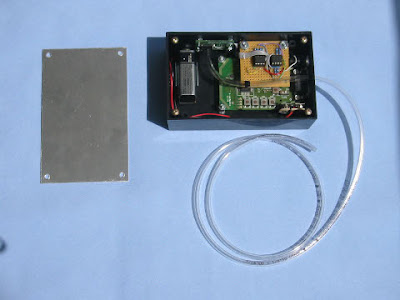AirHopper
 we will develop the jumping locomotion robot in this research.
we will develop the jumping locomotion robot in this research.
This jumping robot can move around the disaster areas where there
are many high steps and obstacles that cannot overcome previous
walking robot, shown in Fig. 1. This developed jumping robot has
both high terrain adaptability and mobility.
more
 During the fabrication of the prototype we had to take into account
During the fabrication of the prototype we had to take into account
several restrictions on the weight and room of the components.
This constraints were imposed by the presence of the flight phase
in the jump.
The robot has two parallel frames, on the right and left hand side,
which are used to keep the motor, the cam shaft and the legs in
place (see picture). In this way it is easy to assembly and
dis-assembly the robot, and the cam and the legs have room to
rotate in the inner part of the robot. Shafts rigidly connecting
the two parallel frames keeps the whole robot firmly resistant
to impacts occurring at every step. This initially was one of
the main problem in making the prototype work, together
with the friction forces
 Biomimetic research at Case Western Reserve University
Biomimetic research at Case Western Reserve University
Our cricket microrobot is being developed by an interdisciplinary
team of faculty and students as part of the DARPA Distributed
Robotics (DR) program. A "micro-robot" is no larger than
5 cm in any dimension. Our robot will locomote by both walking
and jumping and its design is based upon crickets.
http://biorobots.cwru.edu/projects/c_mrobot/c_mrobot.htm
 we will develop the jumping locomotion robot in this research.
we will develop the jumping locomotion robot in this research.This jumping robot can move around the disaster areas where there
are many high steps and obstacles that cannot overcome previous
walking robot, shown in Fig. 1. This developed jumping robot has
both high terrain adaptability and mobility.
more
Jumping Robot Prototype at Stanford
 During the fabrication of the prototype we had to take into account
During the fabrication of the prototype we had to take into accountseveral restrictions on the weight and room of the components.
This constraints were imposed by the presence of the flight phase
in the jump.
The robot has two parallel frames, on the right and left hand side,
which are used to keep the motor, the cam shaft and the legs in
place (see picture). In this way it is easy to assembly and
dis-assembly the robot, and the cam and the legs have room to
rotate in the inner part of the robot. Shafts rigidly connecting
the two parallel frames keeps the whole robot firmly resistant
to impacts occurring at every step. This initially was one of
the main problem in making the prototype work, together
with the friction forces
 Biomimetic research at Case Western Reserve University
Biomimetic research at Case Western Reserve UniversityOur cricket microrobot is being developed by an interdisciplinary
team of faculty and students as part of the DARPA Distributed
Robotics (DR) program. A "micro-robot" is no larger than
5 cm in any dimension. Our robot will locomote by both walking
and jumping and its design is based upon crickets.
http://biorobots.cwru.edu/projects/c_mrobot/c_mrobot.htm











































